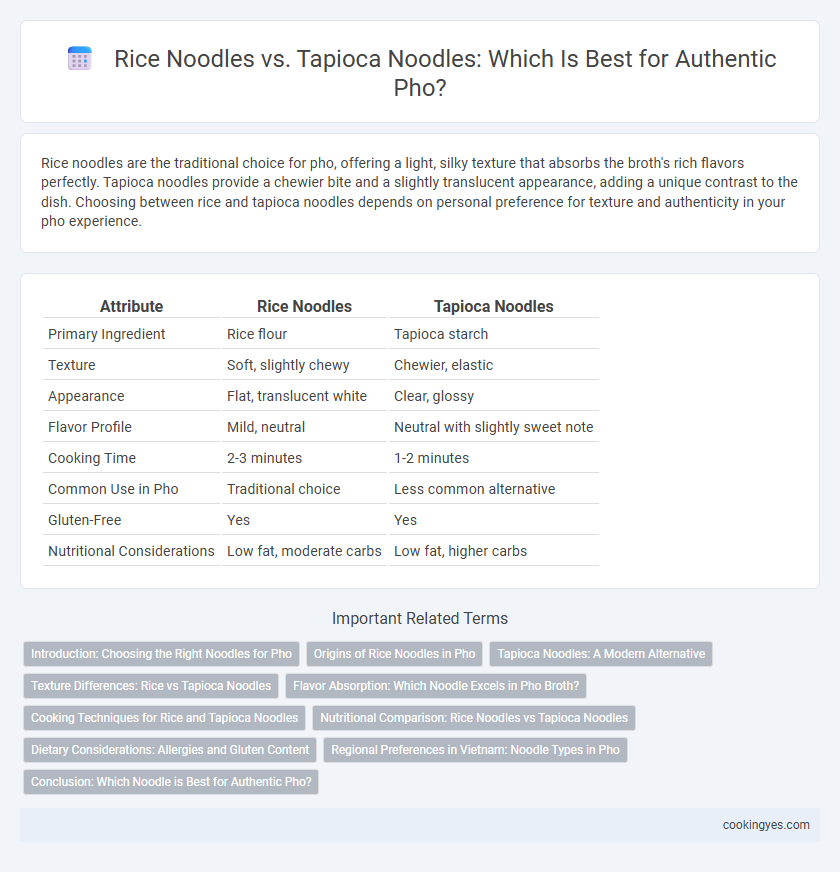Rice noodles are the traditional choice for pho, offering a light, silky texture that absorbs the broth's rich flavors perfectly. Tapioca noodles provide a chewier bite and a slightly translucent appearance, adding a unique contrast to the dish. Choosing between rice and tapioca noodles depends on personal preference for texture and authenticity in your pho experience.
Table of Comparison
| Attribute | Rice Noodles | Tapioca Noodles |
|---|---|---|
| Primary Ingredient | Rice flour | Tapioca starch |
| Texture | Soft, slightly chewy | Chewier, elastic |
| Appearance | Flat, translucent white | Clear, glossy |
| Flavor Profile | Mild, neutral | Neutral with slightly sweet note |
| Cooking Time | 2-3 minutes | 1-2 minutes |
| Common Use in Pho | Traditional choice | Less common alternative |
| Gluten-Free | Yes | Yes |
| Nutritional Considerations | Low fat, moderate carbs | Low fat, higher carbs |
Introduction: Choosing the Right Noodles for Pho
Rice noodles are the traditional and most popular choice for pho, prized for their delicate texture and ability to absorb the broth's rich flavors. Tapioca noodles offer a chewier consistency and a slightly translucent appearance, providing a different mouthfeel that some pho enthusiasts prefer. Selecting between rice and tapioca noodles depends on personal texture preference and the desired balance with the aromatic broth.
Origins of Rice Noodles in Pho
Rice noodles, traditionally made from rice flour and water, have been the authentic choice for pho since its origins in northern Vietnam in the early 20th century. These noodles provide a smooth texture and delicate flavor that complement the aromatic beef or chicken broth, reflecting the culinary heritage of the Red River Delta region. Tapioca noodles, occasionally used to add chewiness, are a modern adaptation but lack the historical and regional significance that rice noodles hold in classic pho recipes.
Tapioca Noodles: A Modern Alternative
Tapioca noodles, crafted from cassava starch, offer a chewy texture and translucent appearance, making them a modern alternative to traditional rice noodles in pho. They provide a gluten-free option while retaining the dish's iconic broth absorption, enhancing flavor without overpowering. Increasingly popular in contemporary pho recipes, tapioca noodles appeal to those seeking innovation and dietary variety in Vietnamese cuisine.
Texture Differences: Rice vs Tapioca Noodles
Rice noodles in pho offer a smooth, tender texture that absorbs the rich broth well, providing a delicate bite essential to traditional Vietnamese cuisine. Tapioca noodles present a chewier, slightly elastic texture that holds up better in longer cooking times without becoming mushy, adding a unique mouthfeel to pho variations. The choice between rice and tapioca noodles significantly affects the pho experience by balancing softness with resilience, influencing both flavor infusion and textural satisfaction.
Flavor Absorption: Which Noodle Excels in Pho Broth?
Rice noodles excel in flavor absorption for Pho broth due to their porous texture, allowing the rich, aromatic spices and savory essence to penetrate deeply, enhancing each bite. Tapioca noodles, while chewier and more translucent, tend to resist soaking up the broth's complex layers, resulting in a milder taste experience. For a traditional Pho, rice noodles remain the preferred choice, maximizing the dish's signature balance of fragrant broth and tender noodles.
Cooking Techniques for Rice and Tapioca Noodles
Rice noodles for pho require soaking in warm water before briefly blanching in boiling broth to maintain their delicate texture, ensuring they remain tender yet firm. Tapioca noodles need more precise timing, often requiring a quick boil followed by immediate cooling in cold water to prevent overcooking and maintain their characteristic chewiness. Mastering these distinct cooking techniques enhances the authentic texture profiles essential for a classic pho experience.
Nutritional Comparison: Rice Noodles vs Tapioca Noodles
Rice noodles in pho offer a lower calorie count and higher protein content compared to tapioca noodles, making them a more nutritious choice for weight-conscious individuals. Tapioca noodles, while richer in carbohydrates, provide a gluten-free option with a chewy texture favored in some regional pho variations. Both noodle types supply essential energy but differ in fiber and glycemic index, with rice noodles generally offering better blood sugar regulation.
Dietary Considerations: Allergies and Gluten Content
Rice noodles in pho are naturally gluten-free, making them an ideal choice for individuals with gluten intolerance or celiac disease. Tapioca noodles also provide a gluten-free option but may cause allergic reactions in some people sensitive to tapioca or cassava starch. Choosing rice noodles ensures a safer dietary option for those with gluten allergies while offering the traditional pho experience.
Regional Preferences in Vietnam: Noodle Types in Pho
Rice noodles dominate northern and central Vietnam's pho, prized for their delicate texture and subtle flavor that complement clear broths. In southern Vietnam, tapioca noodles gain popularity, offering a chewier bite that suits richer, sweeter pho variations typical of the region. Regional preferences shape the pho experience, highlighting how noodle type enhances the balance of broth, meat, and herbs in distinct culinary traditions.
Conclusion: Which Noodle is Best for Authentic Pho?
Rice noodles are the traditional and most authentic choice for Pho, offering a delicate texture and subtle flavor that complements the broth perfectly. Tapioca noodles, while chewier and slightly translucent, do not absorb the complex flavors as effectively and are less common in authentic Vietnamese cuisine. For an authentic Pho experience, rice noodles remain the preferred and culturally accurate option.
Rice Noodles vs Tapioca Noodles for Pho Infographic

 cookingyes.com
cookingyes.com